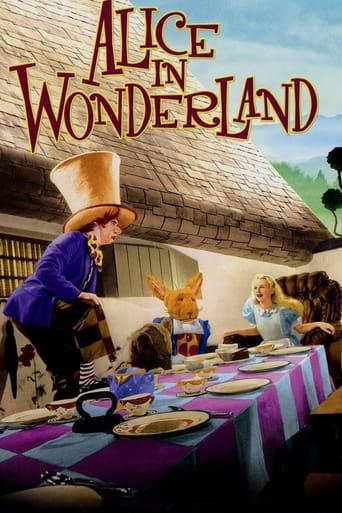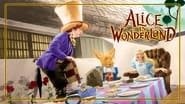classicsoncall
Catching this film on Turner Classic Movies with host Robert Osborne and writer James Curtis offered illuminating insight into the way the picture was made. Screenwriter William Cameron Menzies insisted that every scene be illustrated prior to filming and the drawings became part of the screenplay. The process resulted in a seven pound script that's still intact, as Osborne thumbed through some of the pages to show the viewing audience. It was a laborious process and was never attempted again by Menzies due to it's time consuming nature and the frustration it caused with the actors playing the characters, they had to hunt for their dialog.Seeing this movie for the first time the other day I was surprised how closely it resembled "The Wizard of Oz" in it's execution; you don't really get a sense of it reading the books by Lewis Carroll. There's Alice of course, wonderfully portrayed by the capable Charlotte Henry, perhaps a sweeter version of Judy Garland's Dorothy. The White Knight (Gary Cooper) struck me as an early version of the Tin Man. It was difficult if not impossible to note the individual players in their costumes, the film was one of the first to employ rubber masks, some of which looked rather charming but others notably grotesque. It took me a while to be convinced that was Gary Cooper in the Mock Turtle get up, that was just very strange. Oddly, W.C. Fields made an excellent point about un-birthdays as Humpty Dumpty, it would behoove parents to distract your kids during this scene or you could wind up buying them presents every day.While watching the movie I began wondering why it's not better known or regarded and that question was answered as well by the hosts. Apparently Paramount Pictures, with the inclusion of so many of it's star players at the time, determined they wanted to treat this picture as a special, thereby releasing it for only a single week prior to Christmas of 1933. After that the film sort of sat in hibernation for a long time, and even now this is the first time I've seen it offered on any of the cable stations. At times the picture may be just a bit harsh for youngsters, but as a whimsical fantasy I think every film buff ought to give it a try at least once.
Auntie_Inflammatory
This is my favorite film version of the story that made me a tea-drinker in childhood.Charlotte Henry is the perfect Alice. She really looks the part and is believable as a much younger girl. William Cameron Menzies' art direction is superb. The sets are wonderful. The special effects are amazing for 1933 and still hold up. The music is engaging. This was the second film scored by Dimitri Tiomkin who would go on to win many Oscars, Golden Globes, and Grammys. More than a few people seem to think that the decision to costume most of the actors in masks that obscure their identities was a bad one. I disagree. Menzies wanted the characters to look the way they do in the original versions of Lewis Carroll's books and they really do. In particular, the frog and fish footmen, mock turtle and gryphon look EXACTLY like Sir John Tenniel's illustrations. I can't recall ever seeing another (non-animated) movie based on a children's book where the characters looked so much like the way they do in the book. I think many modern-day viewers are just annoyed at not getting to see a recognizable, young Cary Grant or W.C. Fields. Purists may not like that screenwriter Joseph L. Mankiewicz combined Alice's Adventures in Wonderland and Through the Looking-Glass (didn't Disney do that too?), simplified some of the dialogue, changed the order of some scenes, and omitted others. There's no caucus-race, visit to the rabbit's house, recitation of Father William, story from the Dormouse, Lobster Quadrille or trial. The dodo recites the "dry" history speech that's spoken by the mouse in the book. The Walrus and the Carpenter is very cleverly rendered as a cartoon by Harman-Ising (not Fleischer) studios. Despite the changes, the film does remain faithful to the spirit of the books. If you like the books and can deal with the altered chronology you should like the movie too.Another reviewer here made an interesting point that modern audiences, who grew up watching only the Disney version of "AIW", might not like this because they expect "AIW" to be cute and colorful. I'm pretty sure I saw the re-release of the Disney version as a child but I also loved the books and always thought of Tenniel's depiction of Alice as the true Alice. The fact is, Lewis Carroll didn't do cute. About half the characters Alice encounters are at least somewhat antagonistic towards her. The last scene of the film set in Wonderland is a complete departure from the books. It goes pretty dark for a kid's film. When this aired on TCM recently, as part of a spotlight on Menzies, film historian James Curtis pointed out the similarity between this scene and another from the 1945 horror film "Dead of Night." I've heard this movie described as a flop which is very unfair. It was only released for one week around Christmas 1933. We'll never know if it would've found a wider audience if given more of a chance.
lugonian
ALICE IN WONDERLAND (Paramount, 1933), directed by Norman McLeod, is an interesting screen adaptation to Lewis Carroll's immortal fairy tale mainly for its all-star casting headed by Charlotte Henry in the title role. Although regarded quite faithful to the book, ALICE IN WONDERLAND never achieved the reputation of an immortal motion picture classic as did the better known children's' stories transferred to film, namely Laurel and Hardy's BABES IN TOYLAND (Hal Roach/MGM, 1934) with Charlotte Henry as Bo-Peep; or THE WIZARD OF OZ (MGM, 1939) starring Judy Garland as Dorothy. ALICE IN WONDERLAND did contain more screen adaptations dating back to the silent era than either BABES IN TOYLAND and THE WIZARD OF OZ combined, with the best known "Alice" being the Walt Disney's 1951 animated version. Alice even was paid tribute in a production number scored by Irving Berlin in PUTTIN' ON THE RITZ (UA, 1930) featuring Joan Bennett. This Alice may be noteworthy to some extent but basically a missed opportunity of a great classic.ALICE IN WONDERLAND gets off on a splendid start with its three and a half minute introduction of hand turning the pages of a book, "Alice in Wonderland" and displaying the sketches of characters on one page followed by the faces of actors who play them on another. Opening shot is at an undisclosed location of a two story house being covered by falling snow as Alice (Charlotte Henry), a 12-year-old girl with long blonde hair and ruffled dress, is seen sitting at home along with her governess, Miss Simpson (Ethel Griffies), and pet cat. Bored with nothing to do, she imagines herself going through the mirror, better known as "The looking glass," where she starts her fun-filled fantasy in Wonderland encountering a handful of characters along the way: Uncle Gilbert (Leon Errol) and her Aunt (Patsy O'Byrne); a talking clock (Colin Kenny); The White Rabbit (Richard "Skeets" Gallagher); Mouse (Raymond Hatton); Caterpillar (Ned Sparks); Dodo Bird (Polly Moran); a stuttering Fish (Roscoe Ates); Frog (Sterling Holloway); a cook (Lillian Harmer): the Duchess (Alison Skipworth); the Cheshire Cat (Richard Arlen); the Mad Hatter (Edward Everett Horton); the March Hare (Charles Ruggles); The Dormouse (Jackie Searle); walking play-cards, The Joker (Baby LeRoy); The Queen of Hearts (May Robson who commands "Off with their heads"); the Five of Spades (Charles McNaughton) and The King of Hearts (Alec B. Francis); The Gryphon (William Austin); the crying Mock Turtle (Cary Grant); The Red Queen (Edna May Oliver); Tweedledum (Jack Oakie); Tweedlum (Roscoe Karns); The White King (Ford Sterling), The White Queen (Louise Fazenda); Sheep (Mae Marsh); Humpty Dumpty (W.C. Fields); the accident prone White Knight (Gary Cooper); Plum Pudding (George Ovey); among others before awakening from her dream.With such an impressive cast and imaginative production, how could ALICE IN WONDERLAND miss? The selection of Charlotte Henry was just right (better than Ida Lupino as originally intended at one point), as was W.C. Fields in his five minute segment as Humpty Dumpty. Possibly the weakness is somewhere in the script (by Joseph Mankiewicz) where some scenes hold interest while others do not. The special effects of Alice flying through the air, growing and shrinking in mirror-like effect, quite stunning for its time, while sets by William Cameron Menzies are still quite remarkable. One scene involving a crying baby (Billy Barty) being abused may come off as disturbing, followed by his change into a pig while still squirming in Alice's arms. ALICE IN WONDERLAND at 77 minutes is not an overlong production, though it has indications of being a much longer film since Jacqueline Wells, noted for her role as Alice's sister, is mentioned but not existent in the surviving print. Many top-name stars are virtually unrecognizable in their brief roles, though some of their voices, namely Fields, are unmistakable. While BABES IN TOYLAND and THE WIZARD OF OZ relied on song interludes, interestingly none by Miss Henry. Tunes selected include "Twinkle Twinkle Little Bat" (sung by Edward Everett Horton); "Beautiful Soup" (sung by Cary Grant) "The Warus and the Carpenter" (sung/recited during cartoon segment by Jack Oakie) and "Fill Up the Glasses" (sung by cast). Rarely televised in recent years, there are notable exceptions such as New York City's July 1983 presentation on WNET, Channel 13 (PBS), and June 4, 2001 showing on Turner Classic Movies as part of its star of the month tribute to W.C. Fields. An interesting bit of trivia by TCM host Bob Osborne noting that Mary Pickford was slated to play Alice supported by animated characters. What a worth while Wonderland this might have been! (***)
angelagraphics
I was lucky enough to watch this movie on television a couple of times. The first time was as a child in the early 60's. I was totally fascinated. I think it introduced me to the pleasures of black and white film. The second time I saw it was about 20 years later. I was traveling and had just checked into a wonderful old hotel. I turned on the vintage television to entertain myself as I unpacked. To my amazement there it was. The original Alice in Wonderland! What a marvelous afternoon treat to watch this classic in such a perfect setting.I am so enchanted with this film and so frustrated that such a classic seems to have disappeared entirely. Though I'm sure the animated versions are good, this version is fantastic. For as old as the film is the surreal settings were incredible! I can't imagine this gem is locked away, collecting dust. Its just a shame. It would become a cult classic like Wizard of Oz.



 AD
AD





